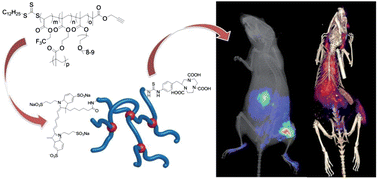Synthesis of a multimodal molecular imaging probe based on a hyperbranched polymer architecture†
Abstract
Molecular imaging is utilised in modern medicine to aid in the diagnosis and treatment of disease by allowing its spatiotemporal state to be examined in vivo. This study focuses on the development of novel multimodal molecular imaging agents based on hyperbranched polymers that combine the complementary capabilities of optical fluorescence imaging and positron emission tomography-computed tomography (PET/CT) into one construct. RAFT-mediated polymerisation was used to prepare two hydrophilic hyperbranched polymers that were differentiated by their size and level of branching. The multiple functional end-groups facilitated covalent attachment of both near infrared fluorescent dyes for optical imaging, as well as a copper chelator allowing binding of 64Cu as a PET radio nuclei. In vivo multimodal imaging of mice using PET/CT and planar optical imaging was first used to assess the biodistribution of the polymeric materials and it was shown that the larger and more branched polymer had a significantly longer circulation time. The larger constructs were also shown to exhibit enhanced accumulation in solid tumours in a murine B16 melanoma model. Importantly, it was demonstrated that the PET modality gave rise to high sensitivity immediately after injection of the agent, while the optical modality facilitated extended longitudinal studies, thus highlighting how the complementary capabilities of the molecular imaging agents can be useful for studying various diseases, including cancer.


 Please wait while we load your content...
Please wait while we load your content...